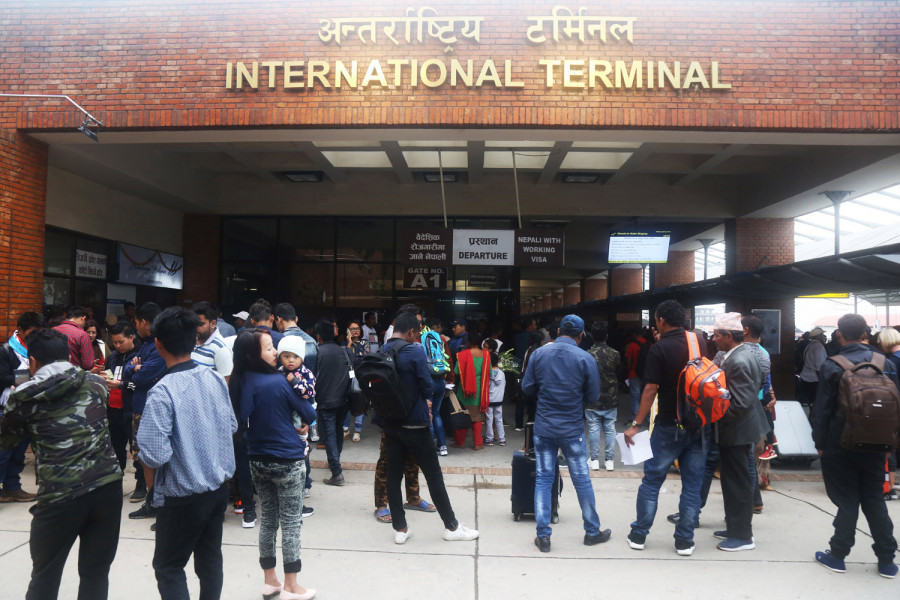Money
Remittance to Nepal may drop to $7.4 billion in 2020, World Bank says
Nepal Rastra Bank rejected the assumption saying growth trends indicate sustained inflows.
Sangam Prasain
Nepali migrant workers are expected to send home only $7.4 billion in 2020, down 12 percent from pre-coronavirus levels in 2019, the World Bank said in its latest estimates.
Nepal’s central bank was more upbeat, saying that the World Bank had been conservative in its assumption, and that there would be no contraction in remittance this year. In 2019, Nepali expatriates sent back $8.2 billion to their families.
The virus‐related global slowdown and travel restrictions will also affect migratory movements, and this is likely to keep remittances subdued even in 2021, according to the World Bank’s Migration and Development Brief released on Thursday.
The report said that tepid economic growth and employment levels in countries hosting migrants, weak oil prices and depreciation of the currencies of remittance-source countries against the US dollar were all factors behind the decline.
Nepal Rastra Bank said the country would not see negative growth in remittance earnings in 2020, but the growth momentum might not last in 2021 as the global economy gets battered by the second wave of the Covid-19 pandemic.
“Remittance grew, except in April and May, against all the odds in the global job providing countries,” said Gunakar Bhatta, spokesperson for Nepal Rastra Bank. “There has been a better-than-expected growth in remittance sent by Nepali migrant workers as of September. Based on the current scenario, we don’t see inflows falling in the next three months either.”
“But as the Covid-19 pandemic is becoming uncertain, we don’t see much optimism in the next year,” he said.
Bhatta, who is also the head of the research department at the central bank, said that many factors helped remittance to swell.
The first and foremost reason, according to Bhatta, is the diversion of remittance from the informal to formal channels. “Almost all migrants, especially those in South Korea and Australia, sent money home through formal channels due to the difficulty of carrying cash under travel restrictions,” he said.
Another cause behind the rise in remittance is that people sent home cash instead of goods, Bhatta added.
In the past, migrant workers would be laden with household goods for gifts when they came home to celebrate the Dashain, Tihar and Chhath festivals.
“This year, due to the difficulties in travel and severe restrictions imposed by many countries, Nepalis did not bring these products.”
Economists said that the growth in money transfers, despite an early prediction by different global agencies that Covid-19 may crash remittance globally including Nepal, indicates that the manufacturing sector has returned to its old self.
“It was estimated that Nepalis working abroad would return home in the millions, with at least 2-3 million coming back, because of the coronavirus outbreak. But that did not happen,” economist Dadhi Adhikari told the Post. “That’s the key factor why remittance has not decreased despite several projections that Nepal would see the inflow falling steeply.”
Adhikari said that in the initial days of Covid-19, the pandemic had spread fear among the millions of Nepalis living abroad, and they all wanted to return to the safety of their homes. “But Nepal’s poor health infrastructure forced them to remain where they were.”
In April-end, a little over a month after the lockdown was imposed on March 24, Nepal Rastra Bank had projected a drop of over 15 percent in remittances in the last fiscal year 2019-20. In the same month, the World Bank also projected remittances to go down by 14 percent. The Central Bureau of Statistics too projected a reduction of Rs163 billion, or over 18 percent.
According to the macro economic report of Nepal’s central bank, the number of Nepali workers (institutional and individual-new and legalised) taking approval for foreign employment plunged by 99.2 percent in the review period. Similarly, the number of Nepali workers (renew entry) taking approval for foreign employment decreased by 86.5 percent in the review period.
The World Bank said that in India and Sri Lanka, remittances are projected to fall by about 9 percent in 2020 to $76 billion and $6.7 billion, respectively. In Pakistan, remittances would grow at about 9 percent, totalling about $24 billion. In Bangladesh too, remittances are projected to grow at about 8 percent to around $20 billion.




 9.12°C Kathmandu
9.12°C Kathmandu















